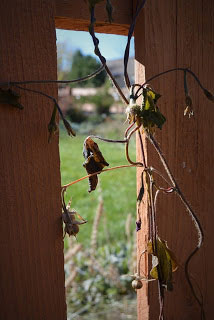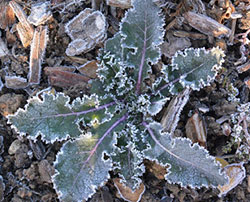2048
Frost and Freeze
Adapted by Steve Geist, Senior Consulting Arborist, Swingle, from the CO-Horts blog originally authored by Mary Small, Colorado Master Gardener Coordinator.
Jack Frost happens. Depending on the temperature and its duration, he can spell the end of the growing season for many herbaceous plants. I pondered the end as I went to look at the garden one morning following a frost. Instead of sighing in disgust I took delight in the magical beauty he left behind and that got me thinking more about frost.
 Morning glory, still beautiful |
What is frost?
We all know what it can do to plants. But what is frost, exactly? According to the National Oceanic and Atmospheric Administration, frost is the “formation of ice crystals on the ground or other surfaces in the form of scales, needles, feathers of fans.” Frost is common when the humidity is high enough, similar to the conditions under which dew is formed. (Dew forms, however, when temperatures are above freezing, not below.)
Does frost kill plants?
Frost alone doesn’t kill plants. That’s why some can survive a visit from Jack and still look fine. Injury happens only when internal plant temperatures drop low enough so that ice crystals form inside plant cells. Cellular liquid freezes, forming the crystals. These sharp objects in turn, puncture cell membranes. As air and plant temperatures warm up, ice crystals liquefy. It leaks out of cells,dehydrating them. Voila! Dead, blackened, wilted-looking plants.
 Frost crystals on a weed |
Which plants can survive frost?
Plants growing close to the soil may survive freezing temperatures a bit longer than others due to warmth generated from the soil. This heat gets conducted up and around the plant at least a few inches. And get this…when soil’s moist, it can hold four times as much heat as a dry one and conduct it faster!
Next time Jack pays a visit, be sure to embrace the beauty he brings. After all, he’s not to blame for plant death. He’s just reducing the sting of season’s end.It’s this soil warming we take advantage of when we cover tender plants, trying to avoid the inevitable. The heat gets trapped underneath the covering and keeps plants warmer than without it.
For more information, see the following Planttalk Colorado™ video(s).



